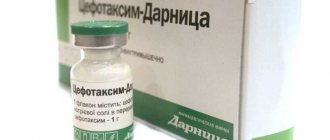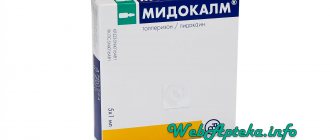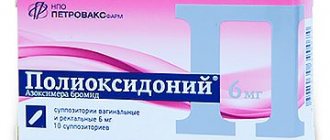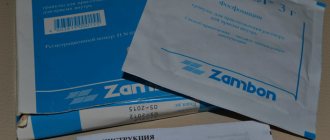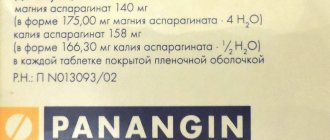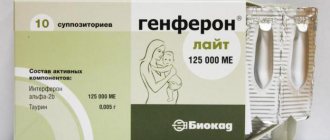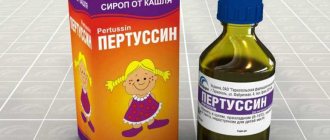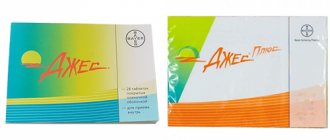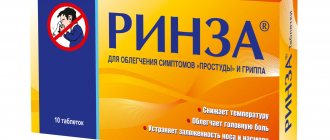Ceftriaxone is a third-generation semi-synthetic antibiotic drug belonging to the group of cephalosporins. It is distinguished by its strong antibacterial effect due to its ability to prevent the growth of membranes of pathogenic cells. The drug is equally effective against aerobic and anaerobic microorganisms. Ceftriaxone injections are prescribed for various infectious diseases.
Pharmacological effect
According to the instructions for use of Ceftriaxone injections, the medicine is a third generation cephalosporin antibiotic. They have an antimicrobial effect by blocking the synthesis of microorganism cell walls. The drug acetylates membrane-bound transpeptidases, which affects peptidoglycan cross-links, which are necessary for the cell walls of the microbe to be strong and resistant to irritants. This drug is effective against various aerobic and anaerobic bacteria. Resistant to beta-lactamases of gram-negative microscopic organisms.
Mechanism of action
Ceftriaxone has a bactericidal and antibacterial effect. The powder dissolves well in water. The drug is suitable for intravenous and intramuscular administration. Upon penetration into the body, the substance is quickly absorbed. Half an hour after an injection into a vein and 60 minutes after an injection into a muscle, the substance reaches its highest concentration in the blood.
The effect of the drug lasts throughout the day, so it is used once a day. Penetrating into the cells of pathogenic bacteria, Ceftriaxone destroys their protective shells and does not allow the formation of new elements of pathogenic microorganisms. The drug is active against many gram-positive and gram-negative aerobes and anaerobes.
Pharmacodynamics
"Ceftriaxone" in injections binds to plasma protein by ninety percent. The presented medical product penetrates quite well into the tissue and various body fluids. Its adequate concentration is observed in the cerebrospinal fluid against the background of meningitis. A large content of the drug is recorded in bile. This medication penetrates the placental barrier, excreting to a small extent in breast milk.
Approximately sixty percent of the antibiotic Ceftriaxone is excreted through the kidneys along with urine, unchanged. The rest of the drug is excreted in the bile. The drug is prescribed for the inflammatory process, which is caused by pathogens that are not resistant to this drug, including in the presence of peritonitis, sepsis, meningitis, shigellosis, chronic carriage of Salmonella, inflammation and abscess of the lungs, pyelonephritis, infectious diseases of the joints and bones, skin and soft tissue, external genitalia and so on.
"CEFTRIAXONE": analogues
The medicine is produced by several Russian pharmaceutical companies: Biokhimik Saransk, Sintez AKOMP, Ruzpharma, Protek SVM, etc. The cost of 1 gram differs by 1-2 rubles. An imported substitute can be bought from 218 to 600 rubles per 1 gram.
Ceftriaxone: analogues in tablets
The tablets contain 3rd generation cephalosporins, with a different active ingredient. As a substitute for ceftriaxone, analogues in tablets can be:
| Suprax Solutab is an Italian drug with the active ingredient cefixime, produced in tablet form. Prescribed for the treatment of infectious and inflammatory diseases. Price – 833 rubles. |
| Pantsef are tablets from the Macedonian pharmaceutical company Alkaloid AD based on cefixime. Prescribed for the treatment of urinary tract infections, otitis, pharyngitis, bronchitis, gonorrhea, etc. Price – 528 rubles. |
Previous generations of cephalosporins are also made into tablets.
"CEFTRIAXONE": analogues in injections
Medicines in which ceftriaxone is the active substance are released only for injection. Among the affordable analogues of ceftriaxone in injections, you can consider:
| Rocephin is a French-Swiss drug. It is based on the same active ingredient. It has an antibacterial and bactericidal effect on the body. Price – from 49.60 rubles per 1 g. |
| Medaxone is a Cypriot broad-spectrum antibiotic. Used to combat infectious diseases of various etymologies. Price – from 171 rubles. |
| Cefazolin is a domestic antibiotic of the cephalosporin class from the first generation. With a similar spectrum of activity and a similar list of diseases for which they are prescribed, cefazolin has more side effects and is less tolerated by patients. Price – from 37.50 rubles per 1 g. |
Important! The choice between these drugs should only be made by a doctor: you cannot use a more modern remedy against flora, which is perfectly treated by the first generation. This will lead to the development of antibiotic resistance in bacteria.
Pharmacokinetics of Ceftriaxone injections
The antibiotic in injections has excellent penetrating ability; the substance bypasses the placental barrier, entering breast milk. The drug remains in the body for quite a long time, usually up to eight hours. Therefore, for a number of diseases, you can do just one injection per day. From the point of view of effectiveness, it does not matter which format of drug administration is chosen: intramuscular or intravenous.
In both of these forms, the antibiotic Ceftriaxone works one hundred percent against the infection. But for some diseases, especially with large doses, only intravenous infusion is prescribed. In babies in the first month of life, as well as in the elderly, the drug can remain in the body for up to one week. The medicine is excreted in equal amounts with bile and urine. The peculiarity of the drug is that if the patient has impaired liver function, then all of the Ceftriaxone can be evacuated through the kidneys. When the kidneys are sick, the drug is excreted in the bile.
How is Ceftriaxone diluted?
Even before the start of outpatient treatment with the drug, patients often have a question about how to dilute Ceftriaxone.
To obtain a solution, doctors use various sterile liquids and even drugs:
- water for injections;
- Novocaine;
- Lidocaine.
The latest medications are painkillers. Their use can reduce the pain experienced by the patient during the administration of the antibiotic and after the injection. It is worth noting that the choice of means for preparing the solution is determined by the place of administration of the prepared drug (intramuscular or intravenous).
When injected into a muscle, the maximum concentration of the active ingredient in the blood is observed after 1.5–2 hours, and when injected into a vein, immediately after the end of the procedure.
How to dilute Ceftriaxone for intramuscular administration?
Having figured out what solutions can be used to prepare the medicine, you need to find out how to dilute Ceftriaxone. Doctors, even before telling how Ceftriaxone injections are diluted directly for intramuscular administration, pay attention to the maximum dosage. With this type of administration, it is allowed to use no more than 1 g of dissolved drug. To dilute the powder and prepare a solution, use water for injection and an anesthetic.
Each type of prepared solution has a number of features:
- Ceftriaxone prepared in water for injection is not capable of causing allergic reactions. However, this solution causes severe pain when administered: the injection is administered very slowly, over 2-3 minutes.
- To save the patient from suffering, Lidocaine and Novocaine are used as a solvent. However, these drugs often provoke anaphylactic shock, so they are used only in hospitals where emergency care is available.
How to dilute Ceftriaxone for intravenous administration?
When prescribing the drug Ceftriaxone, the use of the drug, elimination features, and dosage are determined individually by doctors. If the patient is being treated in a hospital, then preference is given to intravenous drip administration. In this form, the drug not only acts on the pathogen itself, but also helps rid the body of intoxication.
To prepare the solution and place the dropper, use water for injection. When asked by patients whether Ceftriaxone can be diluted in advance, doctors answer negatively. The prepared solution is added to a system filled with glucose or saline solution. Nurses know how to dilute Ceftriaxone in this case, in addition, the information is duplicated in the doctor’s prescription sheet. Lidocaine cannot be used to dilute the antibiotic.
Is it possible to dilute Ceftriaxone with saline?
When looking for a means to prepare a solution, patients often ask their doctor whether it is possible to dilute Ceftriaxone sodium chloride. This substance is isotonic in concentration with respect to blood plasma, therefore it is often used for intravenous infusions. It can be used for dilution if the antibiotic is administered by drip. If the drug is prescribed intravenously as a bolus (administered using a syringe), Ceftriaxone powder must be diluted with water for injection.
Is it possible to dilute Ceftriaxone with Novocaine?
Doubting the admissibility of using anesthetics to prepare an antibiotic solution, patients often wonder whether Ceftriaxone can be diluted with Novocaine. Doctors do not recommend using this drug as a solvent in a particular case. It has been established that Novocain can reduce the therapeutic effectiveness of the antibiotic. In addition, there have been cases of fatal anaphylaxis when an antibiotic was administered with this drug.
Lidocaine is used as an alternative. It relieves pain several times better, in addition, allergic reactions when using this drug rarely occur. To prepare the solution, use a 1% lidocaine solution. How to dilute Ceftriaxone with this anesthetic is discussed below.
Is it possible to dilute Ceftriaxone with Analgin?
Wanting to know about all types of antibiotic solvents, patients ask the doctor whether Ceftriaxone can be diluted with Analgin. At the same time, they pursue the goal of reducing pain during the injection. Doctors do not use Analgin to prepare solutions for parenteral administration. This drug has insufficient analgesic effect, so it is not advisable to use it. Lidocaine is used as a solvent with a pronounced analgesic effect.
Indications for use
In accordance with the instructions for use, Ceftriaxone injections are prescribed to combat the following infectious pathologies:
- For meningitis, blood poisoning and various microbial diseases of the peritoneal organs.
- Against the background of microbial dermatological diseases.
If a person has infectious lesions of the musculoskeletal system, for example, bone tissue or ligaments, then the medication can also help.
Not everyone knows why Ceftriaxone injections help. This medicine is used for pathologies of the kidneys and genitourinary system. Often, the medication in question is prescribed for pneumonia, otitis media, sinusitis and sore throat. This remedy is also effective against the causative agent of gonorrhea.
Side effects
The use of the drug may cause the formation of such adverse reactions as:
- disruption of the functioning of the digestive tract, manifested by nausea, vomiting, stool disorders in the form of diarrhea, stomatitis;
- violation of the hematopoietic system;
- allergic reactions, they can be manifested by the appearance of rash elements, itching, swelling, urticaria, anaphylactic shock;
- headache and dizziness;
- oliguria;
- phlebitis.
The formation of pseudomembranous colitis may occur.
special instructions
Despite the greater effectiveness of the antibiotic Ceftriaxone in injections, we must not forget that this is a very serious drug. In especially rare situations, medications in this series can provoke anaphylactic shock. In this regard, immediately before prescribing Ceftriaxone, the doctor must carefully study the patient’s medical history. In addition, you need to know that the use of this medicine can contribute to the deposition of sand in the kidneys and bladder.
But this shouldn't be scary. As soon as the course of treatment with the drug is completed, the sand will go away on its own. Sometimes it is necessary to take appropriate medications to cleanse the organs. Such accumulations can cause discomfort in the patient. If a patient is prescribed a long-term course of therapy with Ceftriaxone, it is necessary to periodically take blood tests. Long-term use may affect some blood elements. The instructions for using Ceftriaxone injections confirm this.
The medicine is used with great care in the presence of too significant amounts of bilirubin in the body in newly born children, as well as in babies who were born prematurely. The use of the drug in question also requires special monitoring in patients with impaired renal and liver function, colitis and enteritis (including against the background of ulcerative colitis) caused by the use of antibiotics.
Contraindications to the drug
The advantages of Ceftriaxone include the fact that it rarely causes side effects. Exceptions occur only in cases of personal immunity to the patient's components of the drug or its improper use.
Some people, in order to save antibiotics, dilute the drug for future use. This cannot be done, since the shelf life of the diluted powder should not be more than 6 hours. Even if the ampoule with the diluted powder is placed in the refrigerator, the injection of a stale preparation will be much more painful, and can also cause serious allergic reactions.
If there are any contraindications, Ceftriaxone injections are prohibited for children. This drug is highly not recommended for children with signs of individual intolerance. In this case, Ceftriaxone can provoke anaphylactic shock.
The drug is contraindicated in the presence of serious liver and kidney pathologies. This drug is also prescribed with caution for certain diseases of the gastrointestinal tract.
Intramuscular and intravenous use
In accordance with the instructions for use, Ceftriaxone injections can be used intramuscularly and intravenously.
Absolutely all patients who have reached the age of twelve are prescribed 1-2 grams once a day. Or it is prescribed 0.5 grams every twelve hours. It is worth noting that you can use no more than four grams per day. Children up to two weeks of age are given 20–50 milligrams per kilogram of weight per day. If the child weighs more than fifty kilograms, the dosage is equal to the adult norm.
When more than 50 milligrams per kilogram of body weight is used, the medication should be administered intravenously over half an hour. The number of days of treatment largely depends on the diagnosis and complexity of the disease. For the treatment of gonorrhea, this drug is used once in an amount of 250 milligrams. The drug is administered intramuscularly. In order to prevent the development of infection after surgery, one injection of 1 or 2 grams is also given on average one hour before surgery.
For the treatment of meningitis in children, a dosage of 100 milligrams per kilogram of weight is used, but not more than four grams. Ceftriaxone is administered once a day. Depending on what infection the baby is infected with, the course is continued from four to fourteen days. Children suffering from microbial diseases of the dermis and muscles are prescribed from 50 to 75 milligrams per kilogram. You can inject the medicine once, and 25–37 milligrams per kilo every twelve hours is also allowed, but the dosage should not exceed two grams per day.
What else can you learn from the instructions for using the antibiotic Ceftriaxone?
How to dilute the antibiotic Ceftriaxone?
Before injecting Ceftriaxone intramuscularly (intravenously), it is necessary to properly dilute the drug. To do this, you need to refer to the doctor’s prescription sheet, which details the dosage and frequency of administration of the medicine. The drug is available in bottles, sealed with a rubber cap and sealed with a metal ring.
The breeding algorithm itself is as follows:
- The nurse treats the bottle cap with a cotton ball soaked in antiseptic.
- Using a sterile syringe filled with a solvent (water, lidocaine), inject the solution into the bottle.
- Mix thoroughly and shake the bottle until the powder is completely dissolved and a homogeneous solution is obtained.
- Takes the solution from the bottle with another sterile syringe and injects it into the muscle (upper outer quadrant of the buttock) or intravenously, as prescribed by the doctor.
How to dilute Ceftriaxone with Lidocaine?
In order for the medicine to work correctly and quickly, you need to know exactly how to dilute Ceftriaxone with Lidocaine. To prepare the finished solution, use a 1% anesthetic solution. In this case, it is necessary to take into account the dosage prescribed by the doctor and the drug used. Ceftriaxone is available in 500 and 1000 mg doses, so you should be as focused as possible when diluting the antibiotic.
To prepare the required concentration of the active substance, you must adhere to the following schemes:
- To obtain a solution with 0.5 g of Ceftriaxone, a bottle with a dosage of 500 is diluted with 2 ml of 1% Lidocaine (1 ampoule).
- To obtain a solution of 0.5 g of antibiotic using a drug with a dosage of 1000 mg, dilute 4 ml of anesthetic and take 2 ml of the resulting solution for infection.
How to dilute Ceftriaxone with Lidocaine and water?
There is no point in talking separately about how to dilute Ceftriaxone with water for injection - the principle is the same as with Lidocaine discussed above. However, in some cases, doctors have to use an anesthetic and injecting water at the same time. This happens if you only have a 2% lidocaine solution on hand.
In such cases, proceed as follows:
- 2 ml of water for injection and the same amount of lidocaine are taken into the syringe.
- From the resulting volume of solution, 2 ml is used to dilute Ceftriaxone.
Drug interactions
In the case of therapy with Ceftriaxone, you should never combine this drug with drugs from the aminoglycoside group. In addition, Ceftriaxone is considered a fairly strong antibiotic, so it should not be used together with its analogues. If a person is simultaneously prescribed both Ceftriaxone and medications that have a diuretic effect, these medications can be used without any fear. They will not disrupt the functions of the urinary and kidney systems.
The dosage of Ceftriaxone for adults and children must be strictly observed.
Rules for preparing solutions
Before the first administration, it is necessary to do skin tests for sensitivity to Ceftriaxone and lidocaine. Please note that only freshly prepared solutions of the drug are allowed to be used.
For intramuscular administration, 500 mg of the drug is dissolved in 2 ml, and 1000 mg in 3.5 ml of 1 or 2% lidocaine.
For intravenous administration, 0.5 g is dissolved in 5 ml, and 1 g in 10 ml of water for injection. The introduction should be slow, it should last 2-4 minutes.
For intravenous drip administration, it is necessary to dissolve 2 g of the drug in 40 ml of 0.9% sodium chloride solution.
Side effects
According to the instructions, Ceftriaxone in injections, as a rule, provokes a minimal amount of certain undesirable effects. If they occur, do not interrupt the course of therapy. Less than two percent of patients may notice the appearance of rashes on the skin along with swelling of any areas of the body and dermatitis. About six percent of patients experience eosinophilia. One percent of cases of increased temperature and the occurrence of a febrile state were registered. Very rarely, more complex manifestations such as Johnson's syndrome, toxic epidermal necrolysis, exudative erythema multiforme or Lyell's syndrome may occur.
Painful sensations with swelling may also appear where the injection was performed (in approximately one percent of cases). There are even fewer examples of phlebitis associated with intravenous use of Ceftriaxone. If the injection is performed intramuscularly, it is advisable to use painkillers, since this procedure is very unpleasant. Migraine-like pain with dizziness may occur.
There may be an increase in the amount of nitrogen in blood tests. Creatinine may be observed in a urine test. In particularly rare cases, children who have been treated with large amounts of this medication may develop kidney stones. Typically, this manifestation is caused by a combination of the use of Ceftriaxone in ampoules with a long stay in a supine position, and at the same time a ban on drinking a significant amount of drink. Such manifestations usually do not cause any inconvenience, but sometimes provoke disturbances in the functioning of the kidneys. After completing treatment with this medicine, all these problems go away on their own.
Side effects
Like many antibiotics, Ceftriaxone has some unwanted side effects. How many of them and to what extent will appear in each patient largely depends on individual sensitivity. Disorders that occur during the use of the drug include the following pathologies:
- allergic reactions of the skin: itching, redness, rash, dermatitis, sometimes the development of serious disorders such as Quincke's edema, anaphylactic shock, toxic epidermal necrolysis is possible;
- digestive disorders: loss of appetite, nausea and vomiting, heartburn, diarrhea, belching, stomatitis, in severe cases - the development of disturbances in liver function up to acute liver failure;
- pathological changes in blood composition, such as abnormal levels of platelets and leukocytes, anemia, hematuria, basophilia;
- cardiopalmus;
- drowsiness, lethargy, periodic dizziness, sometimes convulsions;
- cough, dry mouth, nosebleeds, development of bronchospasm;
- dysbiosis of the vagina or intestines;
- decreased urine output;
- superinfection.
In addition, local reactions during injection are possible: skin irritation, burning and pain along the vein, puncture or blockage of blood vessels, hematomas, phlebitis. To reduce their likelihood, it is necessary to ensure the cleanliness of the equipment and trust the administration of the medicine only to qualified professionals.
Use for the prevention of infections in patients with liver cirrhosis
Patients who suffer from cirrhosis of the liver can often develop various infections. In this regard, it is very important to choose the right drug for treatment. Studies of a number of drugs, including Ceftriaxone, were carried out by Spanish doctors. For this purpose, one hundred and eleven patients suffering from cirrhosis, additionally complicated by gastric bleeding and microbial infections, were observed in four clinics. Of these people, two-thirds were of the stronger sex at the age of fifty-eight. In most of them, the pathology was caused by chronic alcohol abuse.
Forty-eight percent of the subjects suffered from the disease in the second degree, and the rest - in the third. In addition, there were many complications such as exhaustion, ascites, kidney and liver failure. During therapy, the presence of microbial contamination was detected in eleven percent of patients, which is three times less than without the use of Ceftriaxone. Peritonitis along with spontaneous bacteremia developed in two percent of people, versus twelve who did not take this drug. Gram-negative bacteria were found in only one person who used Ceftriaxone, and in seven more patients who used other drugs.
Thus, the use of Ceftriaxone is much more effective in preventing certain bacterial infections during operations that are associated with cirrhosis of the liver. In addition, Spanish doctors recommend intravenous use of this drug in case of poor liver function, gastric bleeding or encephalopathy. Despite the positive result, scientists recommend conducting similar studies in different countries, since there are some differences in the types of pathogenic microbes.
The instructions for using the antibiotic "Ceftriaxone" in injections do not end there.
General rules for the preparation and administration of Ceftriaxone solution for injection
Diluting Ceftriaxone is essentially no different from making solutions of other antibiotics. Standard requirements for preparing a solution for injection are as follows:
Slow injection of solution
- The substance is prepared immediately before use.
- Take the required amount of the drug in powder and a sufficient volume of solvent.
- When performing an injection, the following condition must be observed: more than 1 g of antibiotic should not be injected into one buttock.
- The drug is injected deeply intramuscularly (almost the entire length of the 5 ml syringe needle) into the upper outer quadrant of the buttock.
- Ceftriaxone is infused very slowly during the injection.
- The prepared solution is used exclusively for a single injection; if only part of the contents of the bottle is used for injection, the remainder is always discarded.
- The drug solution remains stable in physical and chemical properties for 6 hours at room temperature; after this time, the drug must be disposed of.
The quantitative ratio of Ceftriaxone powder and Novocaine will depend on the concentration of the final solution, according to the recipe.
The dosage is determined by the doctor
For intramuscular administration, 0.25, 0.5 or 1 g of antibiotic in the prepared solution can be used. The dosage is determined by the attending physician. In this case, the doctor takes into account the following factors: the type and severity of the pathology, the patient’s age, and the duration of the disease.
Recommended topic:
Fluconazole for cystitis
To get 1 g of the finished drug, you need to add 5 ml of 0.5% Novocaine from an ampoule to a bottle with 1 g of Ceftriaxone powder. If you reduce the volume of anesthetic, there is a risk that the antibiotic will not be able to completely dissolve and large particles of the drug will get stuck in the lumen of the needle.
A remedy against syphilis
Syphilis is a very common disease that can be transmitted from person to person during sexual intercourse. It is this disease that is considered the most common cause of the subsequent development of HIV infection. This is explained by the fact that when syphilis appears, patients very quickly catch HIV. Syphilis is caused by Treponema pallidum, a microscopic organism that is a member of the Treponemataceae family. This parasite can reach a length of seven to fourteen microns, and its appearance resembles a curved spiral. This organism is able to survive only in the human body. Outside of it, such a dangerous microbe as Treponema pallidum dies immediately.
Syphilis can be alleviated with an antibiotic drug called Ceftriaxone. The antibiotic in question, depending on the stage of the existing disease, is prescribed to patients for fourteen or even forty days. The fact that syphilis can be cured through the use of cephalosporins was said more than two decades ago. And as soon as Ceftriaxone appeared on the pharmaceutical market, doctors began to pay special attention to this drug. The presented antibiotic is endowed with a high ability to treat in the presence of Treponema pallidum, and it can very quickly penetrate into all systems, as well as into the organs of the human body. This effect is especially noticeable when it is injected into a muscle.
In addition to organs and systems, this antibiotic can also penetrate into the cerebrospinal fluid, which is extremely important, since in the presence of syphilis, the cerebrospinal fluid undergoes a number of specific changes. In the fight against syphilis, it is worth additionally using the help of some biologically active additives.
We reviewed the instructions for using Ceftriaxone in injections for adults and children. Next, let's take a look at the reviews.
What is Ceftriaxone prescribed for?
Ceftriaxone injections can help in the following cases:
- Angina
The antibiotic is indicated for use for various lesions of the nasopharynx. It is used for severe illness through a dropper directly into a vein or through intramuscular injections. Before this, the solution must be prepared by heating it to body temperature.
In childhood, it is prescribed in the rarest situations when severe suppurative processes with inflammation occur.
The dosage is determined by a qualified specialist.
- Sinusitis
The drug is able to linger at the site of inflammation in the required concentration. To improve the overall picture, you need to simultaneously use various types of mucolytics and vasoconstrictor medications.
To a patient in such conditions, 0.5 to 1 g of the drug is administered intramuscularly twice a day, mixed with Lidocaine (1%). The total period of therapy is at least 7 days.
- Syphilis
The composition of the drug ensures unhindered suppression of the appearance of cells of a bacteriological nature and mucopeptide metabolism. It works best against treponemas when injected into a muscle. It will be possible to overcome syphilis not only at the early stage of the disease, but also in situations of advanced disease, including neurosyphilis, the secondary stage and even latent.
The frequency of administration in 24 hours is no more than 1 to 2 g. To prevent syphilis, the drug is used for 5 days. The primary type of disease is treated for 10 days, and the secondary type – about 3 weeks.
In addition, the pharmaceutical product will help with:
- Epiglottitis lesions;
- Wounds and thermal burns of infectious type;
- Facial infections;
- Bacterial septimecia, meningitis, endocarditis;
- Sepsis;
- Lyme disease;
- Gonorrhea of unadvanced type;
- Typhoid fever.
Occasionally used for preventive purposes during, before and after surgery in people with weak immune systems.
Reviews
Reviews about this antibiotic on the Internet are mostly positive. Patients are satisfied with the treatment and report that thanks to Ceftriaxone they can get rid of various diseases that are caused by pathogenic microscopic organisms.
Dissatisfied comments, as is often the case with most antibiotics, are found about the side effects that this medication often causes. For example, there are complaints of skin rashes and headaches, as well as swelling and redness in the injection area.
Interaction with other medications
Due to the fact that Ceftriaxone suppresses the intestinal microflora, there is a decrease in the production of vitamin K. Therefore, it is forbidden to combine it with medications whose action is aimed at reducing platelet aggregation, because there is a risk of bleeding.
The use of Ceftriaxone and anticoagulants enhances the therapeutic effect of the latter. The simultaneous use of an antibiotic with loop diuretics leads to the formation of nephrotoxicity.
It is prohibited to add Ceftriaxone to solutions for infusions containing calcium (for example, Ringer's solution), or to combine its use with medications such as:
- Amzacrine;
- Vancomycin;
- Fluconazole.
When is Ceftriaxone prescribed to children?
Due to the fact that Ceftriaxone is a rather potent drug, these injections are prescribed to children only if absolutely necessary, while carefully monitoring the dosage and monitoring the condition and response to the drug in the small patient.
Important! The drug can be prescribed to children from birth, due to the fact that significant side effects specifically on the child’s body have not yet been established.
However, the drug shows itself best in the treatment of serious problems, and it is extremely undesirable to inject Ceftriaxone into a child with a common cold or even bronchitis.
Analogs of Ceftriaxone in tablets and suspensions
Substitutes can be generics - drugs with a similar principle of treatment, the same composition. They are cheaper because they go on sale when the patent expires. Ceftriaxone analogues in tablets are widely used. The most common copies contain cefixime or cephalexin. Ceftriaxone analogues of the active substance in tablets are most often prescribed; this is the most convenient form of administration for adults. They are usually consumed after meals or during meals.
For children, it is offered as a replacement for oral suspension. Ceftriaxone analogues in ampoules are rarely prescribed. These forms are recommended for the treatment of pathologies of moderate or mild severity. In case of a complicated course of the disease, injections cannot be avoided.
Cephalexin
Cephalexin is an effective analogue in tablets and capsules. The composition contains 500 milligrams of the active substance - cephalexin, 10, 16 or 20 pieces per pack. The medicine has the same principle of influence and destroys bacterial infections. Indications include pathologies of the respiratory tract, diseases of the skin, kidneys, genitourinary system, infectious lesions of bones and joints. Children are prescribed tablets from birth and are well tolerated. Often used during pregnancy.
There are much fewer contraindications, these include:
- hypersensitivity to the composition;
- Children under 3 years of age should not be given capsules.
Price – from 80 to 94 rubles. The synonym medication is cheaper, but the results are powerful.
Amoxiclav
The Ceftriaxone analogue Amoxiclav belongs to the effective antibacterial agents of the penicillin group. The mechanism of influence is different. The active ingredients are amoxicillin and clavulanic acid. Prescribed for children from 2 months.
Contraindications include:
- intolerance to penicillins, cephalosporins;
- severe forms of liver failure;
- Infectious mononucleosis;
- lymphocytic leukemia
Side effects include:
- nausea;
- diarrhea;
- stomach pain;
- allergic skin rashes;
- candidiasis;
- dizziness.
Rarely, anaphylactic shock and hepatitis occur. The cost ranges from 112 to 850 rubles. Amoxiclav has a weaker effect on pathogenic agents; many bacteria have developed resistance to its components. Sometimes both antibiotics are prescribed in parallel; they are compatible and complement each other.
Amoxicillin
Amoxicillin belongs to the group of penicillins. It can be chosen as a replacement only in cases of mild pathology. Amoxicillin is more easily tolerated by patients, especially children. The active ingredient is amoxicillin. The substitute is available in various forms - tablets, suspensions, capsules, this is its advantage.
The list of contraindications is small, they include:
- hypersensitivity to the cephalosporin series and composition;
- Infectious mononucleosis;
- lymphocytic leukemia
- nausea, vomiting, diarrhea;
- allergies in the form of skin rashes;
- insomnia, dizziness.
In pediatrics it is used at birth. Duration of treatment – from 5 to 14 days. The average price is 540 rubles. The antibiotic has a wider spectrum of influence and a powerful antibacterial effect.
Suprax
Suprax belongs to the 3rd generation antibacterial drugs of a number of cephalosporins, has a wide range of effects. The synonymous medicine is presented in the form of a mixture of powder and granules for the preparation of an injection solution and capsules. The main element in the composition is cefixime. Widely used for respiratory pathologies not complicated by genitourinary tract infections and gonorrhea. The duration of the course is up to 2 weeks.
- renal failure;
- pseudomembranous colitis.
- urticarial rash, itching of the skin, fever;
- vomiting, diarrhea, flatulence, abdominal pain;
- leukopenia;
- migraines, dizziness.
In pediatrics, injections are used from 6 months. Can be used for treatment during pregnancy and lactation. The average cost is 650 rubles. Suprax is considered a worthy replacement and is not inferior in medicinal effect.
Action
As mentioned earlier, it is bactericidal. The instructions for use of Ceftriaxone say that this is a universal remedy, the action of which is due to the ability to suppress the synthesis of the bacterial cell wall.
This drug is effective against most beta-lactamases of gram-positive and negative microorganisms.
Here is a list of the bacteria that Ceftriaxone can affect:
- Gram-positive aerobes. These include penicillinase-producing strains.
- Gram-negative aerobes. To the above are added diplococci of some genera, strains of Proteus vulgaris and Pseudomonas aeruginosa.
- Anaerobes. The exception is Clostridium difficile.
- Microorganisms resistant to cephalosporin antibiotics and methicillin.
When studying the instructions for use of Ceftriaxone, one should pay attention to the pharmacokinetic characteristics of this drug. The main features can be summarized as follows:
- Bioavailability reaches 100%.
- The maximum concentration of the substance when administered intravenously is achieved at the end of the infusion. When administered intramuscularly – 2-3 hours.
- The product binds to plasma proteins by 83-96%.
- The half-life can vary from 5.8 to 8.7 hours. If the administration is intravenous, it will take from 4.3 to 15.7 hours. The duration may depend on the age of the patient, the disease itself, and also on the condition of the person’s kidneys.
- In adults, the concentration of the active substance in the cerebrospinal fluid is several times higher than the minimum inhibitory concentration if the amount calculated by the formula 50 mg/kg was administered. This change can be recorded in 2-24 hours.
How the drug is eliminated from the body is also described in the instructions for use of Ceftriaxone. It leaves the human body unchanged. The kidneys excrete from 33 to 67% (in newborns this figure can reach 70%), and the intestines – 40-50%.
It should be noted that in the case of this drug, hemodialysis is absolutely ineffective. The composition of “Ceftriaxone” cannot be removed from the body with its help.
How to properly administer injections
As mentioned above, it is not recommended to dilute the drug with novocaine due to the large number of problems that arise as a result of this combination. However, the use of lidocaine to dilute the drug, as for an adult patient, is also prohibited due to allergic reactions to lidocaine itself.
Important!
In pediatric practice, Ceftriaxone is recommended to be diluted with water for injection, which is sold in special ampoules.
This makes the injections much more painful, which slightly reduces the ease of use of the medicine. Therefore, if administering the drug to a child becomes a problem, it would be best to visit the treatment room or invite a nurse to your home. The nurse will be able to give the injection more quickly and painlessly, which will significantly facilitate the entire treatment process.
Contraindications
Now it's time to talk about them. Of course, Ceftriaxone should not be administered intramuscularly or intravenously if the patient has hypersensitivity to cephalosporin antibiotics or to auxiliary components.
The medication is prescribed with caution in the following cases:
- Prematurity.
- Too young age (first days of life) or the baby has hyperbilirubinemia.
- Liver or kidney failure.
- Enteritis, nonspecific ulcerative colitis, as well as colitis that is associated with the use of antibacterial drugs.
- Lactation.
If you neglect the contraindications to Ceftriaxone, you may encounter unpleasant consequences.
Plus, an overdose is possible, which is indicated by central nervous system stimulation and convulsions. Unfortunately, hemodialysis and peritoneal dialysis are ineffective in this case, and the medication does not have an antidote. The only thing that will help a person is symptomatic therapy.
Indications
When studying the instructions for the antibiotic “Ceftriaxone”, you need to talk about the conditions for which it is prescribed. The annotation states that this remedy is prescribed for infections that were caused by bacteria sensitive to its active substance.
In general, indications for the use of Ceftriaxone can be divided into the following list:
- Abdominal infections. Including peritonitis, angiocholitis, and empyema of the gallbladder.
- Infections of the respiratory tract and ENT organs. These are lung abscess, pleural empyema, bronchitis, pneumonia.
- Infections of joint, bone, soft tissues, and skin.
- Lesions of the urogenital tract. These are epididymitis, pyelonephritis, cystitis, pyelitis, prostatitis, etc.
- Epiglottitis.
- Wounds and burns accompanied by infection.
- Bacterial septicemia.
- Lesions of the facial or jaw areas of an infectious nature.
- Sepsis.
- Meningitis and endocarditis of a bacterial nature.
- Syphilis.
- Chancroid.
- Lyme disease, also known as tick-borne borreliosis.
- Uncomplicated gonorrhea. This also includes those cases where the pathology was provoked by microorganisms that secrete penicillinase.
- Typhoid fever.
- Salmonella carriage or already developed salmonellosis.
Also, indications for the use of Ceftriaxone include preoperative prophylaxis. It can also be prescribed to people with weakened immune systems.
Infants
For infants who are not yet two weeks old, the daily dose of antibiotic is calculated as 20–50 mg per 1 kg of the small patient’s weight. If the baby is already more than two weeks old, then the amount of the drug increases to 80 mg per 1 kg of weight.
Follow your doctor's recommendations, observe the prescribed dose and duration of treatment.
About the drug
The antibacterial drug belongs to a number of 3rd generation cephalosporins and has a wide spectrum of action. It is often used for infectious diseases of the respiratory tract. The active ingredient is ceftriaxone, in the amount of 0.25 grams in 1 bottle. It is available only in powder form, from which an injection solution is made.
After administration, it has a detrimental effect on gram-positive, gram-negative, aerobic, anaerobic agents. Excretion occurs with urine 65%, the rest with feces and bile. Prescribed in courses, usually from 5 to 10 days. Can be used for diseases of the respiratory system in the perinatal period.
Side effects include:
- problems with the digestive system - stool disorders, flatulence, enterocolitis;
- allergic manifestations with increased sensitivity to the composition in the form of skin rashes;
- deterioration in general health – dizziness, fever, migraines, anaphylactic reactions.
Synonymous drugs vary in price, effects, and auxiliary components. Some work even better than the main drug. A list of cheap analogues can be found below.
Contraindications and special information
They should be used with caution when treating newborn babies with hyperbilirubinemia, renal or liver failure, and premature babies. They are also attentive to its prescription for children who have colitis or enteritis associated with the use of antibacterial agents by the mother during pregnancy or during breastfeeding
It is important to regularly check the status of peripheral blood and look at renal/liver parameters if long-term antibiotic treatment is necessary. This is what the instructions for use for the drug “Ceftriaxone” say
Analogues of this product must also be used quite carefully.
Particular attention should be paid to those patients who have renal or liver failure. They need to constantly monitor the concentration of the drug in the blood plasma.
It is also worth noting that in some cases, an ultrasound of the gallbladder may show dark spots similar to bile clots. But after the end of therapy they disappear.
Drinking alcohol when treatment with Ceftriaxone or its analogues is necessary is prohibited. Their combination can cause cramps in the abdomen or stomach area, vomiting, nausea, decreased blood pressure, shortness of breath, tachycardia, headache, and facial flushing.
Ceftriaxone analogues in suspension
The vast majority of antibiotic tablets are also available in forms suitable for treating children. The packaging contains a strictly controlled amount of the active substance. The suspension prepared according to the instructions and taking the recommended volume ensures the simplicity and effectiveness of antibacterial therapy.
The main analogues of Ceftriaxone in the form of suspensions:
Suprax
The packaging of the drug contains granules in the amount of 30 grams for the preparation of 60 ml of solution. When diluting, add 20 ml of chilled boiled water in 2 stages, shaking the bottle thoroughly each time to completely dissolve the medicine granules. After the resulting foam has settled, you should make sure that the level of the resulting product reaches the mark indicated on the side of the bottle. Add water if necessary.
The prepared suspension can be stored at a temperature of 15 to 25°C for no more than 2 weeks. The product contains 100 mg of cefixime in every 5 ml, the dosage regimen is the same as for adults. The dosage is calculated based on the child’s body weight and is 8 mg/kg body weight. Duration of therapy is up to 14 days. If the effectiveness is low, it is recommended to promptly replace the oral form of the drug with Ceftriaxone.
Composition and release form
This is the first thing to clarify. What is Ceftriaxone? This is an antibiotic whose action is based on the ability to negatively influence the synthesis of peptidoglycan in bacterial cell walls.
This substance looks like a fine-crystalline powder that is white or slightly yellowish in color. It is slightly hygroscopic. One bottle of Ceftriaxone powder can contain 2, 1, 0.5 or 0.25 grams.
This substance is used to prepare solutions used for infusion therapy and injections. The drug is not available in any other forms - no tablets, no pills, no syrups can be found.
Price policy
A set of the Swiss drug “Rocephin” with lidocaine solvent will cost 550 rubles. A bottle of Azaran costs about 277 rubles in pharmacies, Lendatsin costs 244 rubles.
Of course, the drug needed to fight the infection must be prescribed by a doctor. But if you are being treated at your own expense, and your costs for medications are not covered by insurance, then you can always discuss possible options with your doctor and choose a cheaper option.
Manufacturers of imported analogues claim that in production they use only purified ceftriaxone. Thanks to this, their drugs are better tolerated and more effective. Doctors are often guided by this when they prescribe more expensive drugs made on the basis of ceftriaxone. But the patient can decide for himself whether to trust such statements from manufacturers or use the domestic version of the third generation antibiotic, the price of which is quite affordable.
Source www.syl.ru
Ceftriaxone is a powerful antibiotic belonging to the pharmacological group of cephalosporins. The drug is available exclusively in powder form for the preparation of a solution for injection and does not have tablet forms. Ceftriaxone analogues for oral administration belong to the same pharmacological group and have a similar effect.
Analogs
If an antibiotic is contraindicated, it is replaced with analogues. More often, 3rd generation cephalosporin is replaced with powder Rocephin, Azaran, Ceraxon, Cefotaxime . The first analog contains 250 mg of ceftriaxone. The powder is dissolved with sterile water or Lidocaine. Its active component inhibits the biosynthesis of components of the cell walls of the pathogen by inhibiting the synthesis of peptidoglycan molecules.
The substance reduces the activity of transpeptidases responsible for catalyzing the reaction of peptidoglycan transfer to murein. Against the background of such processes, the structure of cells is disrupted. Rocephin has a bactericidal effect on staphylococci, streptococci, and actinobacteria. If the sample test shows that the pathogen is resistant to Rocephin, the patient is prescribed the antibiotic Azaran.
It is taken parenterally. It inhibits the synthesis of microbial cell membranes. The drug is resistant to b-lactamases produced by gram-positive and gram-negative bacteria. Azaran is active against gram-positive aerobic microbes. If the medication is ineffective, it is replaced with Cefaxone.
It contains sodium salt. The substance is designed for parenteral administration. It affects the cell walls of bacteria, disrupting their growth and development. Strains of different groups are sensitive to the effects of Cefaxone. The drug is effective against pathologies caused by anaerobic bacteria. Virus strains that produce beta-lactamases are insensitive to the drug.
Against the background of parenteral administration, high therapeutic concentrations are created in the body. The active substance binds reversibly to blood proteins. Under the influence of intestinal microflora, the drug is inactivated. The half-life of the drug is up to 8 hours. If the functioning of the kidneys and liver is impaired, the half-life increases.
Use of suspensions
- lower and upper respiratory tract (including tonsillitis, sinusitis, pharyngitis, scarlet fever, bronchitis, pneumonia),
- urinary system (complicated and uncomplicated diseases).
It is also recommended for bacterial gastroenteritis and enteritis, otitis.
Suspensions should be taken with caution in case of hypersensitivity to cephalosporins, allergies to penicillin, gastrointestinal diseases, and renal failure. Sometimes, while taking antibiotics "Cedex", "Ixim Lupine", "Pancef" and other cephalosporins in the form of a suspension, patients may experience nausea, diarrhea, abdominal pain, vomiting, headache or dizziness
Most side effects are moderate and disappear quickly after drug withdrawal
Sometimes, while taking antibiotics "Cedex", "Ixim Lupine", "Pancef" and other cephalosporins in the form of a suspension, patients may experience nausea, diarrhea, abdominal pain, vomiting, headache or dizziness. Most side effects are moderate and disappear quickly after discontinuation of the drugs.

